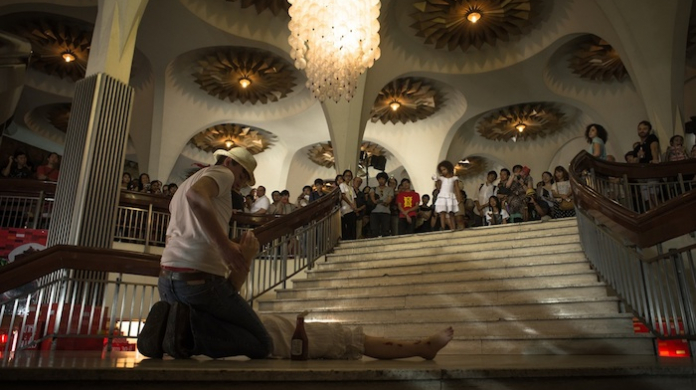Forest Fringe began in an old church hall above the Forest Cafe in Edinburgh. It began with an opportunity to put on a programme of unusual performance work in that empty space during the Edinburgh Festival in 2007. It began with very little else other than that.
From the outset, the aim of Forest Fringe was to make space for unconventional artists and projects that might not otherwise be able to find a home at the Edinburgh festival. This meant everything from intimate interactive encounters; to hand-made animated films, to a live art stunt show, to one man climbing up a ladder for thirty days in an attempt to reach space.
It also meant unfinished work, new experiments, discussions, residencies, parties - in short- anything that an artist wanted to do that we thought sounded wonderful and ludicrous. And, equally importantly, we wanted all of this to be free to audiences; to encourage them to take a chance on, and build a new relationship with, this thrillingly unpredictable collection of artists.
Without any funding the only way that we could make this possible was by inviting the artists we programmed to help us by volunteering their time to help run the venue. From this necessity, a philosophy of generosity and co-operation grew that has become absolutely central to Forest Fringe. As we have begun to explore new contexts beyond the Edinburgh Festival, this spirit of grass-roots collaboration and experimentation remains the most important thing that we have offer.
The microfestival is a concept we have developed over the last three years as a means by which to recreate a microcosm of our Edinburgh Festival events in new places across the UK and beyond. Responding to the space and context we have been invited to occupy, we curate a bespoke line-up of artists from the Forest Fringe community, as well incorporating residencies, workshops, discussions, and importantly, local artists, from whatever country it is we might be visiting.
As such, we were incredibly excited when the opportunity arose to present Forest Fringe microfestivals in Thailand and Japan; whilst we have presented significant events in Europe before, this was our first experience of Asia, and to stretch the versatility of the Forest Fringe microfestivals furthering than we’ve ever previously done.
In the space of a fortnight we had the challenge of creating two radically different events for two completely different kinds of audience in two very different though equally beautiful venues in different parts of the continent.
In Thailand we inhabited a remarkable old cinema in the heart of Bangkok, spilling out into its dressing rooms and its foyers with a programme of work that explored live performance’s relationship to cinema in a myriad of unconventional ways. We had hundreds of audience members over three nights, who interacted with the artists in all manner of ways, from helping recreate a Western movie, to playing spies in a secret one-on-one performance.
And - despite the distance - it did feel like there was something of Edinburgh here, amidst the energy of the artists and the curiosity of the audience. This was the first time anything of this kind had been seen in Bangkok and the encouragement from local artists, audiences and the press to make something like it happen again next year was wonderful reward for the challenge of making it happen.
In Japan things couldn’t have been more different. We found ourselves in Yokohama as part of the Tokyo Performing Arts Market (TPAM), the country’s most high-profile showcase of performance work for an audience of delegates from across Asia and beyond.
We had a series of incredible interlinked warehouse spaces on the top floor of one of the event’s major hubs in which to create a project that would show some of the many ways in which artists from the UK are making work out of their relationship to the city. At the heart of this was a space, we invited a range of Forest Fringe artists to work alongside Japanese artists to create completely new work in response Yokohama; a hive of making and thinking and talking in the midst of a showcase far more familiar with completely finished work.
Despite the differences between these projects, amongst both audiences I felt a tangible interest in the process and the values that underlined what we were doing with Forest Fringe. People were keen to interact and find out more about the artists; to understand more about where we’d come from, and why we found ourselves so far from home. In both contexts this conversation became a crucial part of the event, reinforcing the uniquely playful, informal and interactive nature of what we try and do.
Through working so closely with the British Council we have been able to understand how much we both want and need to know about the countries that we are planning to make these projects in. They have shown us what a significant impact proper local knowledge and understanding can have the quality of the event you present. Their experience of the local environment and its audiences’ shaped and directed the way in which we created these events. By serving as a bridge between our little community of artists in the UK and these very different places, they provide the foundation for the sharing of thoughts and ideas and experiences that are at the heart of all Forest Fringe’s projects.
I don’t know where we might end up next, I know I’d love to explore other radically different contexts, perhaps in South America or in Lebanon where we already have some interesting relationships with artists, but I hope that wherever we end up, it will have the same kind of impact that these recent projects have undoubtedly had, on both us and the local community.
